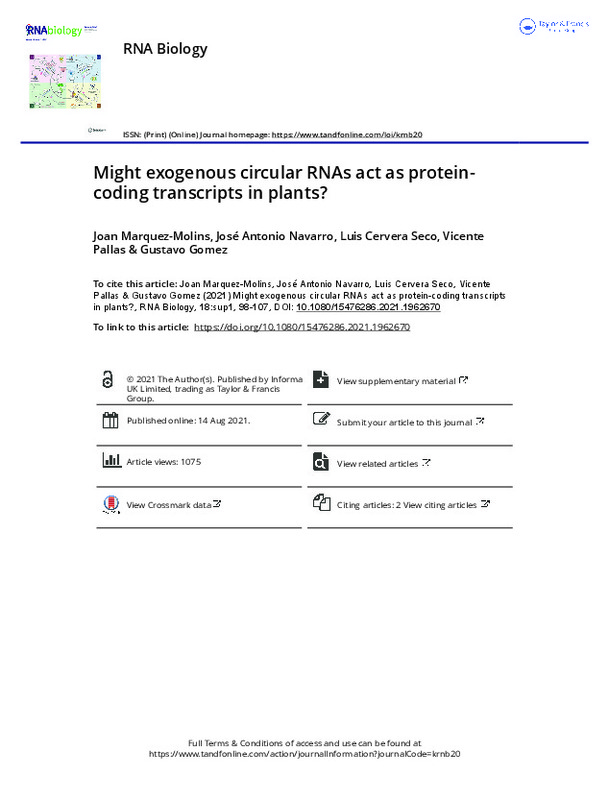JavaScript is disabled for your browser. Some features of this site may not work without it.
Buscar en RiuNet
Listar
Mi cuenta
Estadísticas
Ayuda RiuNet
Admin. UPV
Might exogenous circular RNAs act as protein-coding transcripts in plants?
Mostrar el registro sencillo del ítem
Ficheros en el ítem
| dc.contributor.author | Márquez-Molins, Joan
|
es_ES |
| dc.contributor.author | NAVARRO BOHIGUES, JOSE ANTONIO
|
es_ES |
| dc.contributor.author | Cervera Seco, Luis
|
es_ES |
| dc.contributor.author | Pallás Benet, Vicente
|
es_ES |
| dc.contributor.author | Gomez, Gustavo Germán
|
es_ES |
| dc.date.accessioned | 2022-04-29T18:04:01Z | |
| dc.date.available | 2022-04-29T18:04:01Z | |
| dc.date.issued | 2021-10-15 | es_ES |
| dc.identifier.issn | 1547-6286 | es_ES |
| dc.identifier.uri | http://hdl.handle.net/10251/182297 | |
| dc.description.abstract | [EN] Circular RNAs (circRNAs) are regulatory molecules involved in the modulation of gene expression. Although originally assumed as non-coding RNAs, recent studies have evidenced that animal circRNAs can act as translatable transcripts. The study of plant-circRNAs is incipient, and no autonomous coding plant-circRNA has been described yet. Viroids are the smallest plant-pathogenic circRNAs known to date. Since their discovery 50 years ago, viroids have been considered valuable systems for the study of the structure-function relationships in RNA, essentially because they have not been shown to have coding capacity. We used two pathogenic circRNAs (Hop stunt viroid and Eggplant latent viroid) as experimental tools to explore the coding potential of plant-circRNAs. Our work supports that the analysed viroids contain putative ORFs able to encode peptides carrying subcellular localization signals coincident with the corresponding replication-specific organelle. Bioassays in well-established hosts revealed that mutations in these ORFs diminish their biological efficiency. Interestingly, circular forms of HSVd and ELVd were found to co-sediment with polysomes, revealing their physical interaction with the translational machinery of the plant cell. Based on this evidence we hypothesize about the possibility that plant circRNAs in general, and viroids in particular, can act, under certain cellular conditions, as non-canonical translatable transcripts. | es_ES |
| dc.description.sponsorship | This work was supported by the Spanish Ministry of Economy and Competitiveness (co-supported by FEDER) PID2020-115571RB-I00VP) and AGL2016-79825-R (GG), and by the Spanish Ministry of Science and Innovation (co-supported by FEDER) Grant PID2019104126RB-I00 (GG). JMM was the recipient of a predoctoral contract supported by the Conselleria d ' Educacio, Investigacio, Cultura i Esport Generalitat Valenciana -ACIF Programme (ACIF-2017-114). The funders had no role in the experiment design, data analysis, decision to publish, or preparation of the manuscript;Conselleria d'Educacio, Investigacio, Cultura i Esport [ACIF-2017-114];Ministerio de Economia, Industria y Competitividad, Gobierno de Espana [AGL201679825-R];Ministerio de Econom?a, Industria y Competitividad, Gobierno de Espana [PID2020-115571RB-I00];Ministerio de Ciencia, Innovacion y Universidades [PID2019-104126RB-I00]. | es_ES |
| dc.language | Inglés | es_ES |
| dc.publisher | Landes Bioscience | es_ES |
| dc.relation.ispartof | RNA Biology | es_ES |
| dc.rights | Reconocimiento - No comercial - Sin obra derivada (by-nc-nd) | es_ES |
| dc.subject | Circular RNAs | es_ES |
| dc.subject | Plant coding circRNAs | es_ES |
| dc.subject | Non canonical transcripts | es_ES |
| dc.subject | Plant pathogenic RNAs | es_ES |
| dc.subject | Viroids | es_ES |
| dc.subject | Viroid-derived peptides | es_ES |
| dc.title | Might exogenous circular RNAs act as protein-coding transcripts in plants? | es_ES |
| dc.type | Artículo | es_ES |
| dc.identifier.doi | 10.1080/15476286.2021.1962670 | es_ES |
| dc.relation.projectID | info:eu-repo/grantAgreement/GVA//ACIF%2F2017%2F114/ | es_ES |
| dc.relation.projectID | info:eu-repo/grantAgreement/AEI/Plan Estatal de Investigación Científica y Técnica y de Innovación 2017-2020/PID2019-104126RB-I00/ES/REDES REGULADORAS GENICAS INFLUENCIADAS POR EL AMBIENTE IMPLICADAS EN EL CONTROL DE LA REPUESTA A ESTRES EN MELON/ | es_ES |
| dc.relation.projectID | info:eu-repo/grantAgreement/AEI/Plan Estatal de Investigación Científica y Técnica y de Innovación 2017-2020/PID2020-115571RB-I00/ES/LA MODIFICACION N6-METILADENOSINA (M6A) DEL RNA Y EL DIRECCIONAMIENTO DUAL A CLOROPLASTOS Y MITOCONDRIAS COMO MECANISMOS REGULADORES EN LA BIOLOGIA DE LOS VIRUS RNA DE PLANTAS/ | es_ES |
| dc.relation.projectID | info:eu-repo/grantAgreement/MINECO//BIO2017-88321-R//DESCRIFRANDO INTERACCIONES VIRUS-PLANTA ESENCIALES PARA LA SUSCEPTIBILIDAD Y/O RESISTENCIA EN DOS PATOSISTEMAS AGRONOMICAMENTE RELEVANTES/ | es_ES |
| dc.relation.projectID | info:eu-repo/grantAgreement/MINECO//AGL2016-79825-R//Validación funcional de las redes de SNCRNAS que regulan la repuesta a estrés en melón. Análisis de su potencial como fuente de tolerancia a condiciones ambientales adversas/ | es_ES |
| dc.rights.accessRights | Abierto | es_ES |
| dc.contributor.affiliation | Universitat Politècnica de València. Instituto Universitario Mixto de Biología Molecular y Celular de Plantas - Institut Universitari Mixt de Biologia Molecular i Cel·lular de Plantes | es_ES |
| dc.description.bibliographicCitation | Márquez-Molins, J.; Navarro Bohigues, JA.; Cervera Seco, L.; Pallás Benet, V.; Gomez, GG. (2021). Might exogenous circular RNAs act as protein-coding transcripts in plants?. RNA Biology. 18:98-107. https://doi.org/10.1080/15476286.2021.1962670 | es_ES |
| dc.description.accrualMethod | S | es_ES |
| dc.relation.publisherversion | https://doi.org/10.1080/15476286.2021.1962670 | es_ES |
| dc.description.upvformatpinicio | 98 | es_ES |
| dc.description.upvformatpfin | 107 | es_ES |
| dc.type.version | info:eu-repo/semantics/publishedVersion | es_ES |
| dc.description.volume | 18 | es_ES |
| dc.identifier.pmid | 34392787 | es_ES |
| dc.identifier.pmcid | PMC8677015 | es_ES |
| dc.relation.pasarela | S\444891 | es_ES |
| dc.contributor.funder | MINECO | es_ES |
| dc.contributor.funder | Generalitat Valenciana | es_ES |
| dc.contributor.funder | Agencia Estatal de Investigación | es_ES |
| dc.contributor.funder | European Regional Development Fund | es_ES |
| dc.contributor.funder | Ministerio de Economía y Competitividad | es_ES |








